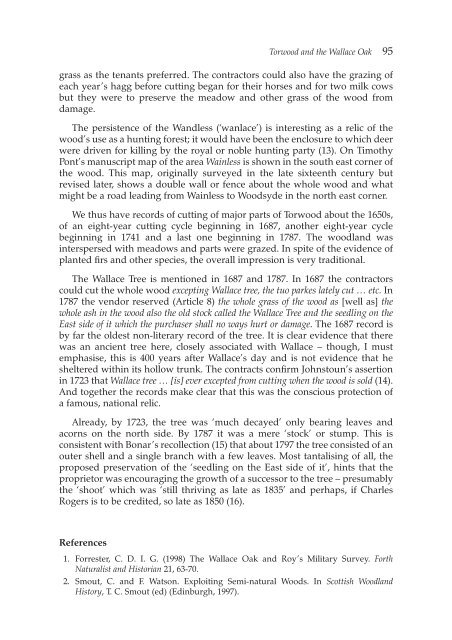the Forth Naturalist Historian - Forth Naturalist and Historian ...
the Forth Naturalist Historian - Forth Naturalist and Historian ...
the Forth Naturalist Historian - Forth Naturalist and Historian ...
Create successful ePaper yourself
Turn your PDF publications into a flip-book with our unique Google optimized e-Paper software.
grass as <strong>the</strong> tenants preferred. The contractors could also have <strong>the</strong> grazing of<br />
each year’s hagg before cutting began for <strong>the</strong>ir horses <strong>and</strong> for two milk cows<br />
but <strong>the</strong>y were to preserve <strong>the</strong> meadow <strong>and</strong> o<strong>the</strong>r grass of <strong>the</strong> wood from<br />
damage.<br />
The persistence of <strong>the</strong> W<strong>and</strong>less (‘wanlace’) is interesting as a relic of <strong>the</strong><br />
wood’s use as a hunting forest; it would have been <strong>the</strong> enclosure to which deer<br />
were driven for killing by <strong>the</strong> royal or noble hunting party (13). On Timothy<br />
Pont’s manuscript map of <strong>the</strong> area Wainless is shown in <strong>the</strong> south east corner of<br />
<strong>the</strong> wood. This map, originally surveyed in <strong>the</strong> late sixteenth century but<br />
revised later, shows a double wall or fence about <strong>the</strong> whole wood <strong>and</strong> what<br />
might be a road leading from Wainless to Woodsyde in <strong>the</strong> north east corner.<br />
We thus have records of cutting of major parts of Torwood about <strong>the</strong> 1650s,<br />
of an eight-year cutting cycle beginning in 1687, ano<strong>the</strong>r eight-year cycle<br />
beginning in 1741 <strong>and</strong> a last one beginning in 1787. The woodl<strong>and</strong> was<br />
interspersed with meadows <strong>and</strong> parts were grazed. In spite of <strong>the</strong> evidence of<br />
planted firs <strong>and</strong> o<strong>the</strong>r species, <strong>the</strong> overall impression is very traditional.<br />
The Wallace Tree is mentioned in 1687 <strong>and</strong> 1787. In 1687 <strong>the</strong> contractors<br />
could cut <strong>the</strong> whole wood excepting Wallace tree, <strong>the</strong> tuo parkes lately cut … etc. In<br />
1787 <strong>the</strong> vendor reserved (Article 8) <strong>the</strong> whole grass of <strong>the</strong> wood as [well as] <strong>the</strong><br />
whole ash in <strong>the</strong> wood also <strong>the</strong> old stock called <strong>the</strong> Wallace Tree <strong>and</strong> <strong>the</strong> seedling on <strong>the</strong><br />
East side of it which <strong>the</strong> purchaser shall no ways hurt or damage. The 1687 record is<br />
by far <strong>the</strong> oldest non-literary record of <strong>the</strong> tree. It is clear evidence that <strong>the</strong>re<br />
was an ancient tree here, closely associated with Wallace – though, I must<br />
emphasise, this is 400 years after Wallace’s day <strong>and</strong> is not evidence that he<br />
sheltered within its hollow trunk. The contracts confirm Johnstoun’s assertion<br />
in 1723 that Wallace tree … [is] ever excepted from cutting when <strong>the</strong> wood is sold (14).<br />
And toge<strong>the</strong>r <strong>the</strong> records make clear that this was <strong>the</strong> conscious protection of<br />
a famous, national relic.<br />
Already, by 1723, <strong>the</strong> tree was ‘much decayed’ only bearing leaves <strong>and</strong><br />
acorns on <strong>the</strong> north side. By 1787 it was a mere ‘stock’ or stump. This is<br />
consistent with Bonar’s recollection (15) that about 1797 <strong>the</strong> tree consisted of an<br />
outer shell <strong>and</strong> a single branch with a few leaves. Most tantalising of all, <strong>the</strong><br />
proposed preservation of <strong>the</strong> ‘seedling on <strong>the</strong> East side of it’, hints that <strong>the</strong><br />
proprietor was encouraging <strong>the</strong> growth of a successor to <strong>the</strong> tree – presumably<br />
<strong>the</strong> ‘shoot’ which was ‘still thriving as late as 1835’ <strong>and</strong> perhaps, if Charles<br />
Rogers is to be credited, so late as 1850 (16).<br />
References<br />
Torwood <strong>and</strong> <strong>the</strong> Wallace Oak 95<br />
1. Forrester, C. D. I. G. (1998) The Wallace Oak <strong>and</strong> Roy’s Military Survey. <strong>Forth</strong><br />
<strong>Naturalist</strong> <strong>and</strong> <strong>Historian</strong> 21, 63-70.<br />
2. Smout, C. <strong>and</strong> F. Watson. Exploiting Semi-natural Woods. In Scottish Woodl<strong>and</strong><br />
History, T. C. Smout (ed) (Edinburgh, 1997).



